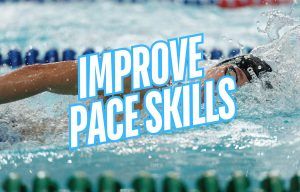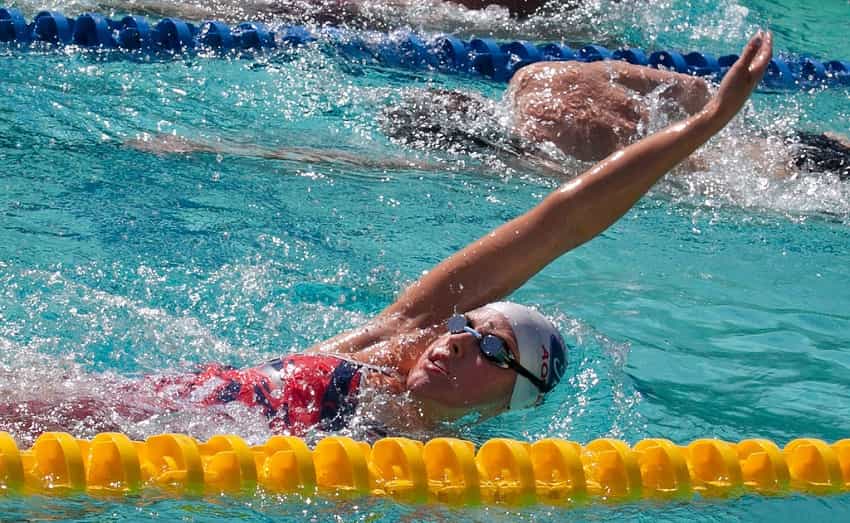
How to Improve Your Pacing Skills
Looking to up your pacing skills in the pool? Here are some actionable pacing tips and tools to help you master pace and your performance on race day.

When you improve your feel for the water you become a more efficient, and ultimately, faster swimmer. Here is how to do it.
When coaches talk about elite swimmers you very often hear about how they have an intuitive and border-line mythical relationship with the water. You’ll hear descriptions like, “He has a special relationship with the water,” or “She has an uncanny feel for the water.”
Statements tell us the elite athletes in our sport are so finely attuned to how their body relates to the water that it defies explanation.
After all, our sport is more about being efficient and drag-free than being a monster in the gym. Intuitively, you already know that you can be the strongest person in the weight room but that a high bench PR doesn’t correlate to a stronger catch or faster pull.
The thing that separates top-level swimmers from mere mortals is largely their efficiency and feel for the water. Being able to find a balance between pulling too hard in the water and pulling just enough. Of being able to catch more water than the swimmer in the next lane.
So how do we improve this aspect of our swimming?
We’ve all had those practices where we feel like we are slipping through the water. Where no matter how hard we try, that our hands feel like they are unable to properly grasp the water, leaving us feeling like we are thrashing and overly exerting ourselves.
Here are a few ways that you can improve your feel for the water:
It’s natural to want to stick to your best stroke all of the time. We want to sharpen our most powerful weapon, and so we focus all of our energy, time and training to it. It’s fun doing what we do best, after all.
So we can be forgiven for being a little confused when our coaches decide to have us swim a significant portion of practice doing one of our off-strokes.
Outside of also being helpful in building aerobic capacity, training your off strokes means you have to manipulate the water in a different way. Think of it as highly specialized cross-training for your best stroke that also helps you increase your feel for the water.
Sculling is a powerful and highly versatile way to improve the relationship you have with the water.
The versatility is limited only by your imagination. Think of sculling as your swiss army knife for improving the way you hold and feel the water. It’s endlessly customized to what you want to focus on that particular day.
See Also: Sculling for Swimmers: The Sneaky Tool for Faster Swimming
Is your hand slipping out during the catch? Spend some time up there sculling. Feel like you aren’t closing out your stroke properly? Grab a snorkel, put your head down and spend time sculling back there.
Use a pull buoy or swim training fins with a light kick to maintain proper body positioning when sculling and remember to emphasize continuous and deliberate pressure on the water with your hands.
There’s no shortage of swim equipment out there, and some of it can dramatically improve your feel for the water.
When we talk about feel for the water we are typically talking about the pulling motions. But with a pair of DragSox you can also help to improve your foot’s feel for the water. When you take them off for the first time your kick will feel “fuller”, if that makes any sense.
When it comes to your hands you can grab a pair of tennis balls and swim freestyle with them. Similar to closed-fist drill, it forces you to make do with less surface area to complete a pull, while the added buoyancy also means you need to really focus on a proper pulling motion.
Hand paddles will help you have a proper hand placement during your stroke—for most freestylers, in particular, they will slide their hand in thumb-first. Finger paddles are probably best, as when you take off paddles larger than your hands it feels like you’ve actually lost some of that precious “feel”.
Another old-school way to ramp up how good you feel in the water is to use your favorite drag suit. Alternate reps wearing your draggiest of drag suits with a more snug (or even a junky tech suit) to feel that extra burst of speed when you removed the “parking” brake that the drag suit creates.
Similar to sculling you can employ a wide variety of drills in order to improve specific components of your stroke and increase your feel for the water at the same time.
The key to doing drill work is performing it with mindfulness and intention, and to actually focus on the drill aspect of it.
A common problem with younger swimmers is that they have a hard time turning off the competitive instinct when doing drill work. Instead of doing it properly they rush through it to beat the swimmer in the next lane.
Remember: drill work not done perfectly is completely wasteful. All you are doing is introducing and ingraining bad technical habits into your swimming. Either do them mindfully or don’t do them at all.
Don’t have the gear? Not sure if you are doing the drills correctly? Introduce super slow swimming to your training.
This is hands-down one of my favorite ways to get my feel for the water back. It also requires no equipment and can be used intermittently before, between and after hard sets to keep form and feel intact between hard efforts.
All you need to do is swim very slowly with great technique. (Turning off the urge to go fast will be harder than expected the first time you did this.)
Doing everything at 1/4 speed means you have to be extra attentive about every aspect of your stroke, including the hand entry and pulling motion. It’s like suddenly walking super slowly; the things you never thought about before like foot placement, moving your leg, are all suddenly things you have to think about now.
In truth about developing an awesome feel for the water is straight-up consistency. More time spent in the water, swimming with deliberate focus on technique, increases it over time.
It’s tempting to look at dryland as a substitute for swimming, but nothing will help you develop your feel for the water more than being in the water, having your hands in there playing with various speeds and pressures.
You know what it’s like being out of the water for a few days—those first few meters always feel a little foreign, your hands initially struggling to regain the touch.
Developing a better feel for the water happens over time, with consistency. The more you are in the water, the better you learn to move through it.
It simply feels amazing when our feel for the water is with us, when we glide across the top of the water with a long, fast, and effortless stroke.
Incorporate some mindful drills, some sculling, and do it with consistency and you will be well on your way to developing that mythical feel for the water.

Olivier Poirier-Leroy Olivier Poirier-Leroy is the founder of YourSwimLog.com. He is an author, former national level swimmer, two-time Olympic Trials qualifier, and swim coach.
✅ Free shipping on Orders over $49
✅ Price Match Guarantee
✅ Best selection of gear for training and competition
✅ Fast and Easy Returns

“This is the best book I have ever seen concerning mental training.” — Ray Benecki, Head Coach, The FISH Swim Team


Looking to up your pacing skills in the pool? Here are some actionable pacing tips and tools to help you master pace and your performance on race day.

Looking for tips on how to use a drag chute for improved swim performances? Read on for some proven tips, sets, and pointers for training with a chute.

Ready to take your swimming to the next level? Here are seven ways that a drag chute can help you become a better and faster swimmer.

Wondering if a swim bench can help improve your swimming? Here are six benefits of swim benches for better technique, more power, and faster swimming.

Not breathing into the walls is one of the fundamental skills developing swimmers are taught. Here is how powerful a no-breath approach is for turn and swim speed. Strong training habits are something swimmers hear a lot about from their earliest days of their competitive swimming careers. The greatest hits

Drills with a swim snorkel are one of the best ways to maximize engagement and skill development. Here are five swim snorkel drills to try for faster swimming.
SITE
SHOP
GUIDES

LANE 6 PUBLISHING LLC © 2012-2025
Join 33,000+ swimmers and swim coaches learning what it takes to swim faster.
Technique tips, training research, mental training skills, and lessons and advice from the best swimmers and coaches on the planet.
No Spam, Ever. Unsubscribe anytime.
